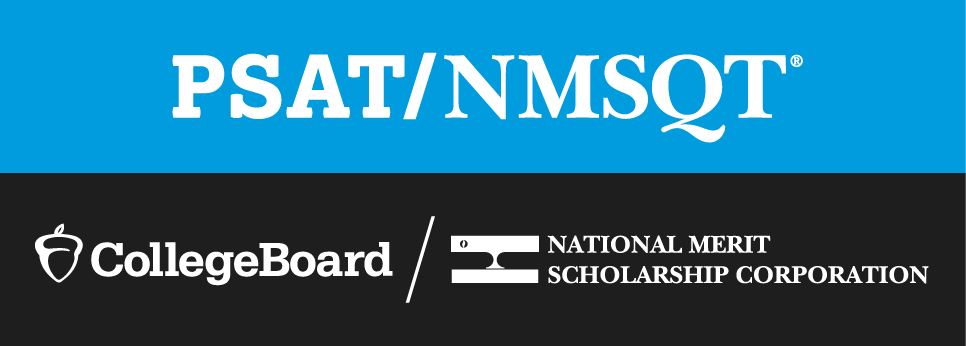Each fall, the College Board administers the PSAT, which is also known as the National Merit Scholarship Qualifying Test (NMSQT). As a rule, students take the PSAT/NMSQT in their high school in their 10th and 11th grade years, with their 11th grade score determining whether they qualify for National Merit.
2023 Administration
The PSAT was administered in October. For the first time, the PSAT was both digital and adaptive, rather than paper-pencil.
DIGITAL: BLUEBOOK APP
Students took the digital PSAT on the College Board’s Bluebook app. The virtual nature of the test should make it more secure and less vulnerable to cheating, as each student receives a different exam. Bluebook:
-
- Saves students’ progress and stops the timer in the event of an internet or power outage, allowing students to pick up where they left off.
- Prevents students from opening web browsers or other applications to search for correct answers.
- Is equipped with Desmos, a highly sophisticated graphing calculator that many students are already familiar with (though students can use their own calculators and/or scratch paper if they prefer).
- Allows students to mark problems they want to go back to, annotate passages, and cross out answer choices.
Another benefit of the digital test is that scores should come back more quickly. All students should receive their scores by mid-November, which is a bit earlier than in years past.
ADAPTIVE: BY SECTION
The digital PSAT includes a Reading/Writing section and a Math section. Within each section, students take two modules. They start with the Reading/English section, where the first module contains a mix of easy, medium, and hard questions; each question has an associated difficulty level. Depending on their performance on the questions on the first module, students will advance to an easier or harder second module, which will broadly determine their score range. After a short break, they do the same with Math. The following table shows the structure and timing of the test.
Reading/Writing
- 54 questions (27 per module)
- 64 minutes (32 per module)
- 1:11 per question
Math
- 44 questions (22 per module)
- 70 minutes (35 per module)
- 1:35 per question
All told, the test takes a maximum of 2 hours, 14 minutes. This is quite a bit shorter than the paper-pencil PSAT that had been administered in prior years. Some other specific differences from the paper-pencil exams include the following:
- Every Reading and English passage is short and only has one question, as opposed to long passages with multiple problems
- There is no longer a “no-calculator” math section – students are permitted to use a calculator on every math problem
- Each math problem will only have one question; in the past, multiple problems could be linked to the same information
It should be noted that not all students will have taken the digital, adaptive exam. Though Bluebook does provide an extended time option, students who receive certain accommodations may still take the “linear,” non-adaptive, paper-pencil PSAT,
Scoring
Most students are familiar with the top scores they can achieve on standardized tests: 36 on the ACT, 1600 on the SAT. The PSAT works a little differently. While there is a maximum score (1520 – 760 on Reading/Writing, 760 on Math), what’s more important for National Merit purposes is the Selection Index, which is the score the PSAT uses to determine National Merit eligibility. To calculate the Selection Index:
- Divide each section score by 10.
- Multiply the Reading/Writing score by 2.
- Add the Reading/Writing and Math scores to get the Selection Index (maximum of 228).
So, the Selection Index for an example student who scored 1400 overall, with 720 in Reading/Writing and 680 in Math, would be calculated as follows:
- Reading/Writing score: 72. Math score: 68.
- New Reading/Writing score: 144.
- Selection Index: 144 + 68 = 212.
You might notice that this appears to advantage students with stronger verbal abilities because the Reading and Writing section score is doubled – and you’d be right. Here’s the Selection Index for the same composite score of 1400 but with the Reading/Writing and Math scores from the previous example flipped:
- Reading/Writing score: 68. Math score: 72.
- New Reading/Writing score: 136.
- Selection Index: 136 + 72 = 208.
For each section, there will be overlap in scores between the highest scorers in the easy module and the lowest scorers in the hard module. However, if a student lands in the easier second module, they will not be able to attain the maximum score of 760; their score will be capped somewhere below that.
National Merit Qualification
While many sophomores and nearly all juniors will take the PSAT, the exam’s purpose may feel a bit opaque. Students may know that PSAT scores are used to determine whether they qualify for National Merit, but the different levels of recognition and chances of getting an actual scholarship through the program might be confusing. We’ll try to clear up some of that muddiness here.
There are several score cutoffs along the way to receiving a National Merit Scholarship.
- The first level of recognition is National Merit Commendation. Approximately 50,000 PSAT-takers reach this level or beyond, with about two-thirds (34,000 or so) receiving commendation. The cutoff for the Class of 2024 (the current senior class) is 207, which remains unchanged from the previous year. However, Commended Students are not eligible for National Merit Scholarships.
- Approximately one-third of Commended students (historically, about one percent of all PSAT-takers) qualify as National Merit Semifinalists. This level of recognition is determined on a state-by-state basis, meaning the threshold for qualification in Wisconsin is different than it is for students in New York or California or Wyoming. (These state-level thresholds do not apply to students at boarding schools, who are grouped with other boarding school students in their region of the country.) For the Class of 2024, the Semifinalist cutoff for Wisconsin is 213. It’s impossible to know for certain if that Selection Index threshold will increase, decrease, or stay the same for the Class of 2025, especially because of the PSAT’s transition to a digital, adaptive exam. That said, Wisconsin’s Selection Index has hovered right around 213 for the past several years, so that’s a reasonable target score. Commended students and Semifinalists are notified of their status around the beginning of their senior year, when the official cutoffs are announced.
- Semifinalists then have the opportunity to become National Merit Finalists and be considered for a scholarship. There are two requirements for Semifinalists: 1) fill out the National Merit Scholarship Application, and 2) take an SAT or ACT to “confirm” their PSAT performance. (More information from National Merit is here.) Nearly all Semi Finalists go on to become Finalists, but only about half of the Finalists will receive one-time National Merit Scholarships of $2,500. There are also 1,100 Special Scholarships available, which are sponsored by corporations or colleges; these range from one-time payments of $2,500-$5,000 to renewable awards or stipends of $500-$10,000 per year.
More information on specific types of scholarships can be found in this year’s official PSAT/NMSQT student guide. The list of scholarships, with criteria and corresponding monetary amounts, starts on page 37.
So, to sum up: students must 1) clear the Semi Finalist Selection Index threshold, 2) submit an application to become a Finalist, and 3) be selected as a Finalist to qualify for National Merit Scholarships. But even without a scholarship, the various levels of National Merit recognition can bolster college applications.
Alternatives
These levels of recognition (Commended, Semifinalist, Finalist) represent the standard path to National Merit recognition. However, there are two other ways to achieve it.
- Alternate Entry. Students can attempt to qualify for National Merit if they were unable to take the PSAT (for example, if they were sick on test day) by submitting an SAT score instead. The Selection Index through Alternate Entry works the same way as with the PSAT, but the SAT section scores are capped at 760 (instead of 800) to match the PSAT’s scale. One important note on the SAT: as with the PSAT, it is shifting to a digital and adaptive exam starting in March 2024, and the structure will be identical to that of the PSAT. Before the transition, there is one more paper-pencil SAT administration in December.
- College Board National Recognition Programs. These programs allow students who are African American or Black, Hispanic American or Latinx, Indigenous, or attend school in a rural area or small town to achieve recognition based on their PSAT (or AP) scores. This link lists the criteria required to attain such recognition. These are not scholarship programs, but as College Board states, “students can include this academic honor in their college and scholarship applications.” Colleges may also reach out to qualifying students with scholarship opportunities.
Conclusion
A strong PSAT performance can both enhance your college applications and lead to merit scholarships. If you are a junior and think your PSAT score may qualify you for National Merit recognition, you might want to familiarize yourself with the requirements of the National Merit program and application process. Additionally, any sophomores with high scores on the ACT or SAT (if they’ve taken those exams already) or this fall’s PSAT might want to consider spending some time preparing for the PSAT with Galin next year. Feel free to reach out to us with any questions about preparing for the PSAT or how you can use your PSAT/NMSQT scores to your advantage in the college application process!





